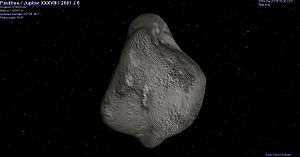Pasithee (moon)
| Pasithee | |
|---|---|
| Pasithee in an artistic animation in the computer program Celestia | |
| Provisional or systematic name | S / 2001 J 6 |
| Central body | Jupiter |
| Properties of the orbit | |
| Major semi-axis | 23,096,000 km |
| Periapsis | 16,929,000 km |
| Apoapsis | 29,263,000 km |
| eccentricity | 0.267 |
| Orbit inclination | 165.138 ° |
| Orbital time | 719.44 d |
| Mean orbital velocity | 2.33 km / s |
| Physical Properties | |
| Albedo | 0.04 |
| Apparent brightness | 23.2 mag |
| Medium diameter | ≈ 2 km |
| Dimensions | ~ 1.5 × 10 13 kg |
| Acceleration of gravity on the surface | ≈ 0 m / s 2 |
| Escape speed | ≈ 0 m / s |
| discovery | |
| Explorer | |
| Date of discovery | December 11, 2001 |
| Remarks | retrograde orbit |
Pasithee (also Jupiter XXXVIII) is one of the smaller outer moons of the planet Jupiter .
discovery
Pasithee was discovered on December 11, 2001 by astronomers at the University of Hawaii. It was initially given the provisional designation S / 2001 J 6.
The moon was named after Pasithea , one of the Charites from Greek mythology .
Orbit data
Pasithee orbits Jupiter at a mean distance of 23,004,000 km in 719 days, 10 hours and 34 minutes. The track has an eccentricity of 0.2675. With an inclination of 165.138 ° the orbit is retrograde, that is, the moon moves around the planet against the direction of rotation of Jupiter.
Due to its orbital properties, Pasithee is assigned to the Carme group , named after the Jupiter moon Carme .
Physical data
Pasithee has a mean diameter of about 2 km. Its density is estimated at 2.6 g / cm³. It is probably made up mainly of silicate rock. Pasithee has a very dark surface with an albedo of 0.04; that is, only 4% of the incident sunlight is reflected. Its apparent brightness is 23.2 m .
Web links
- MPEC 2002-J54: Eleven new Satellites of Jupiter May 15, 2002 (discovery)
- IAUC 7900: Satellites of Jupiter May 16, 2002 (discovery)
- MPEC 2003-F59: S / 2001 J 6 March 29, 2003 (rediscovery)
- IAUC 8177: Satellites of Jupiter, Saturn, Uranus August 8, 2003 (numbering and naming)
| before | Jupiter moons | after that |
| Kale | Pasithee |
Hegemone |
